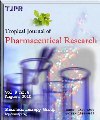
|
Tropical Journal of Pharmaceutical Research
Pharmacotherapy Group, Faculty of Pharmacy, University of Benin, Benin City, Nigeria
ISSN: 1596-5996
EISSN: 1596-5996
Vol. 15, No. 10, 2016, pp. 2227-2233
|
 Bioline Code: pr16293
Bioline Code: pr16293
Full paper language: English
Document type: Research Article
Document available free of charge
|
|
|
Tropical Journal of Pharmaceutical Research, Vol. 15, No. 10, 2016, pp. 2227-2233
| en |
Structural characterization of inclusion complex of arbutin and hydroxypropyl-β-cyclodextrin
Li, Yun; Li, Fang; Cai, Hongyan; Chen, Xuan; Sun, Wei & Shen, Wangyang
Abstract
Purpose: To improve the solubility and stability of arbutin and to expand its application by preparing its
inclusion complex with hydroxypropyl-β- cyclodextrin (HP-β-CD).
Methods: An inclusion complex made of arbutin and hydroxypropyl-β-cyclodextrin (HP-β-CD) was
prepared by freeze-drying method. Various analytical techniques, including ultraviolet-visible
spectroscopy (UV), Fourier transform infrared spectroscopy (FT-IR), scanning electron microscopy
(SEM), x-ray diffractometry (XRD) and thermo-gravimetric/differential scanning calorimetry (TG/DSC),
were used to characterize the inclusion complex.
Results: UV spectra indicated that no new unsaturated bond was formed in the inclusion complex.
Infrared analysis showed that the smaller peaks in the proximity of 1450 - 1600 cm-1 were characteristic
of the aromatic nucleus, indicating that the phenyl ring of arbutin was involved in the formation of the
inclusion complex. Scanning electron micrographs of the inclusion complex showed that the original
morphology of both components disappeared, and some tiny aggregates of amorphous areas of
irregular size were present, revealing that the arbutin was dispersed in HP-β-CD. The powder XRD
pattern of the inclusion complex was more similar to that of amorphous HP-β-CD and did not exhibit the
characteristic peaks of arbutin which suggest that arbutin in HP-β-CD matrix was molecularly dispersed,
and existed in an amorphous state. The TG curve of the inclusion complex was a one-step process,
partly proving the formation of the complex. Complex formation with HP-β-CD remarkably improved the
physical and chemical stabilities of arbutin.
Conclusion: Inclusion complex of arbutin with HP-β-CD improves the heat stability of arbutin
remarkably. This has a potential for expanding the application of arbutin to pharmaceuticals and food.
Keywords
Arbutin; Hydroxypropyl-β-cyclodextrin; Inclusion complex; Physicochemical properties; Stability; Solubility
|
| |
© Copyright 2016 - Pharmacotherapy Group, Faculty of Pharmacy, University of Benin, Benin City, 300001 Nigeria.
Alternative site location: http://www.tjpr.org
|
|
